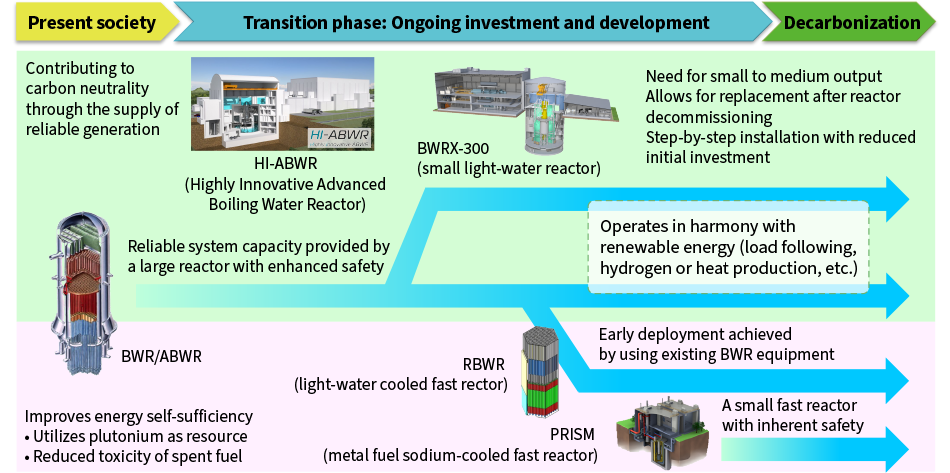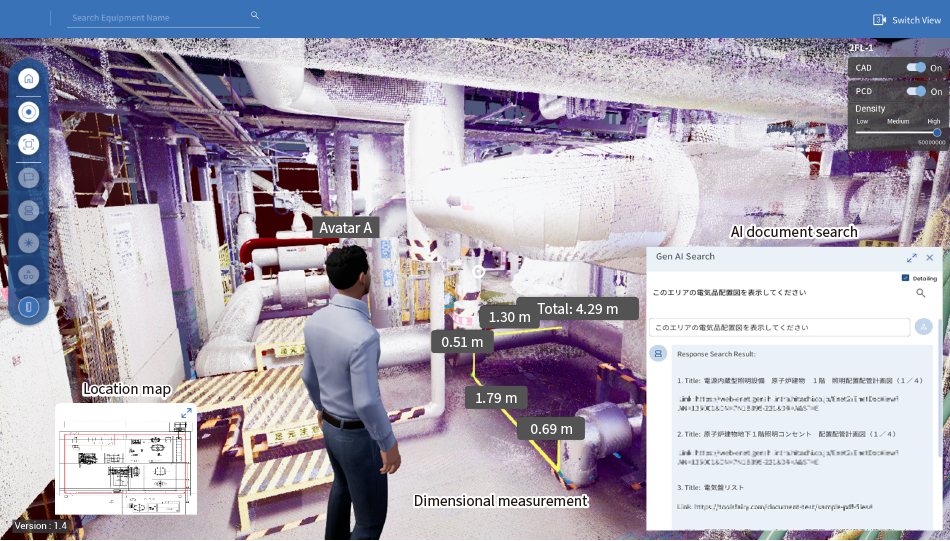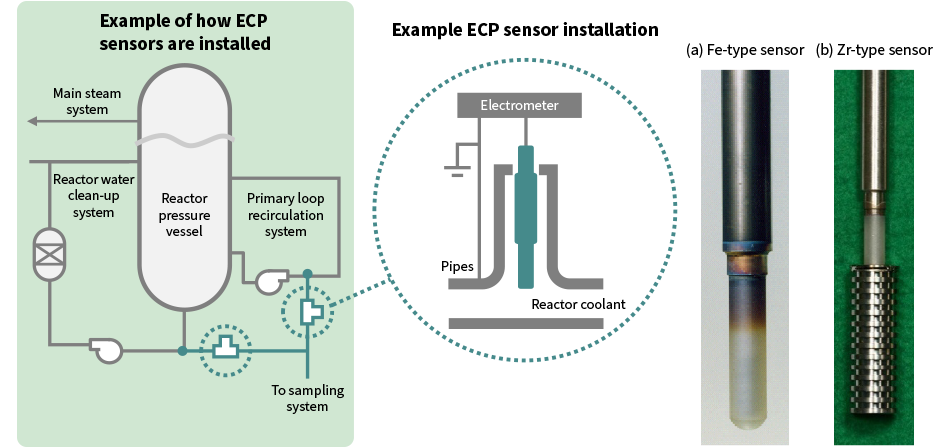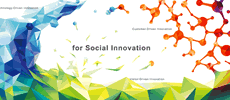Hitachi’s Efforts in the Nuclear Sector (1)Research and Development of Nuclear Sector (Overview)
Highlight
Recognizing the seriousness of the accident at the Fukushima Daiichi Nuclear Power Plant, Hitachi has been cooperating with all aspects of the work on plant decommissioning and the recovery and reconstruction of the affected area while also seeking to rebuild confidence in nuclear power. Meanwhile, with the effects of climate change now making themselves felt around the world in forms such as record-breaking heatwaves and heavy rainfall events, progress is being made on bringing renewable energy into more widespread use as a means of decarbonizing society. However, acknowledging the vulnerability of renewable energy to variable weather conditions, people are coming to realize once more how important it is that renewables play a complementary role with nuclear power, a reliable energy source that does not emit any CO2 in the generation process. Other factors that have entered the conversation more recently are the needs of economic security in a changing international order and the anticipated growth in demand for electric power due to the progress of DX and GX.
Taking these circumstances into account, this article describes work on ensuring the security of electricity supply and on achieving carbon neutrality. This includes efforts to commercialize the large, highly innovative reactor design, progress on the development of the BWRX-300 SMR through international cooperation, and O&M enhancements that make the most of existing reactors to improve the capacity factor and address long-term operation. It also covers the development of environmental improvement measures at the Fukushima Daiichi Nuclear Power Plant, just one of many initiatives underway aimed at smoothing the progress of decommissioning.
1. Introduction
Moves to achieve carbon neutrality have picked up pace over recent years. Already, more than 150 nations and regions have announced goals of carbon neutrality by 2050 (or by 2070 in some cases). Among them, Japan has expressed its strong resolution to address climate change as a nation, having made international commitments to a 46% reduction in greenhouse gas emissions by FY2030 and carbon neutrality by 20501) Nuclear power generation is widely recognized as a source of decarbonized energy that plays a major part in achieving carbon neutrality. At the 28th United Nations Climate Change Conference (COP28) held in December 2023, a cooperative strategy was announced that set the ambitious target of a three-fold increase in the global installed capacity of nuclear power plants (reactors) by 2050 relative to 2020 in order to achieve the Paris Agreement goal of limiting the mean global temperature rise to no more than 1.5°C above pre-industrial levels. As of November 2024, the strategy has been ratified by Japan and 30 other nations2). Meanwhile, prompted by the anticipated growth in demand for electric power from data centers in particular, countries such as France and the UK are pressing ahead with new reactor construction and the USA has announced a roadmap for tripling its installed capacity of nuclear power plants3).
The construction of new plants will be essential if the global installed capacity of nuclear power generation is to increase significantly and if Japan is to maintain the level of nuclear power generation it needs while also providing for the decommissioning of aging plants. This in turn will require reactors that can suit the needs of a variety of different markets, combining economic performance with high levels of safety using practices informed by lessons from the accident at the Fukushima Daiichi Nuclear Power Plant. Accordingly, Hitachi-GE Nuclear Energy, Ltd. has been working to commercialize its large-scale Highly Innovative Advanced Boiling Water Reactor (HI-ABWR) and to develop its BWRX-300 small modular reactor (SMR) as innovative next-generation reactor design for new light-water reactors that can satisfy these needs.
It is also important to take parallel steps to maximize the use of existing reactors to ensure reliable levels of electricity generation. Europe and the USA are already doing so by using maintenance optimization to improve the capacity factor of plants and extend their operating lives. Similarly, Japan’s Energy White Paper 2024 identifies a need for similar such action to maximize the use of existing reactors4). Hitachi-GE Nuclear Energy, meanwhile, has been working on ways to achieve this efficiently while also ensuring high levels of safety and reliability, using digital technology to enhance operation and maintenance (O&M) and developing maintenance techniques that address plant aging.
It has been nearly 14 years since the March 2011 accident at the Fukushima Daiichi Nuclear Power Plant. Surveys and other preparations for the removal of fuel debris are ongoing. Moreover, with the commencement of trial removal in Unit 2, the decommissioning work moved on in September 2024 to the third phase specified in the Mid-and-Long-Term Roadmap. To safely and reliably conduct full-scale fuel debris removal, it is important to establish the right conditions both inside and outside the building. To provide a better work environment, Hitachi-GE Nuclear Energy has been working on removing the highly contaminated water present in pipes and other equipment. Because of the potential build-up of inflammable gas (hydrogen) left over from the accident or produced by the radiolysis of contaminated water, this has included the development of an electrochemical drilling technique that eliminates the risk of explosion when opening holes in the pipes. The preliminary sampling needed to establish a water removal plan has also been successfully accomplished. These techniques are being used in various water removal plans and are contributing to creating better work environments.
This article presents an overview of these latest technologies under development at Hitachi-GE Nuclear Energy.
2. Overview of Developments in Main Business Sectors
2.1 Development of Next-generation Reactors (Highly Innovative Light-water Reactor and SMR)
Hitachi-GE Nuclear Energy has a reactor development strategy that takes a step-by-step approach to deliver diverse solutions to meet societal needs (see Figure 1). As shown at the top half of the figure, since it is important in the comparatively near future to contribute to carbon neutrality (CN) by providing reliable sources of electric power, we think that light-water reactors will play an important role as the current mainstay of nuclear power plants. Subsequently, as shown in lower part of the figure, since the improvements in energy self-sufficiency achieving the use of plutonium (Pu) as a fuel and reducing the toxicity of spent fuel is to be more important to meet the need for ongoing use of nuclear power, the plan is to make use of fast reactors (where fission is driven by fast neutrons). This section describes two light-water reactors.
The Advanced Reactor Working Group at Japan’s Advisory Committee for Natural Resources and Energy has laid out a roadmap for introducing innovative light-water reactors (large light-water reactors) to Japan from the mid-2030s, with a high level of technical maturity. They also plan to introduce small light-water reactors in the 2040s, following the earlier progress of projects in Western countries5). Hitachi-GE Nuclear Energy is working on the implementation of the HI-ABWR for large-scale light-water reactors and developing the BWRX-300 as a highly economical small light-water reactor, corresponding to this roadmap.
The HI-ABWR is a large-scale reactor with an output of 1,350 to 1,500 MWe, based on the internationally standardized ABWR which has already received design certification in the UK (UK ABWR). It incorporates safety enhancements based on the lessons learned from the Fukushima Daiichi Nuclear Power Plant accident and includes new safety mechanisms in its safety systems. These include enhanced resilience to natural disasters, terrorism, and internal hazards; passive safety systems that do not require power or operator intervention; and a filter vent system with a noble gas distributor that significantly improves the containment of radioactive substances during a severe accident.
The BWRX-300 is an SMR with 300-Mwe-class electric output that is being jointly developed with the sister company GE Hitachi Nuclear Energy in the USA. The reactor is based on the Economic Simplified BWR (ESBWR) that already has design certification (DC) in the USA. It combines enhanced safety with simplified plant systems, using an advanced reactor concept featuring reactor pressure vessel isolation valves to effectively mitigate the impacts of loss-of-coolant accidents (LOCAs). It also has passive safety systems for the removal of decay heat. The design is expected to achieve equal or better economic performance compared to that of large reactors. The first BWRX-300 unit will start commercial operation in Canada as early as 20296). Hitachi also plans to deploy the reactor to the Japanese market utilizing its licensing and construction experience in Europe and the USA.
The HI-ABWR and BWRX-300 designs described here are ready for early deployment. In the future, Hitachi intends to align with nuclear power policy, incorporate user views, strengthen its social acceptability, and help to achieve carbon neutrality.
Figure 1—Hitachi-GE Nuclear Energy’s Reactor Development Strategy BWR: boiling water reactor, ABWR: advanced BWR, HI-ABWR: highly innovative ABWR, RBWR: resource renewable BWR, PRISM: Power Reactor Innovative Small ModuleThrough its development of new reactor designs, Hitachi-GE Nuclear Energy is taking a step-by-step approach to deliver diverse solutions.
BWR: boiling water reactor, ABWR: advanced BWR, HI-ABWR: highly innovative ABWR, RBWR: resource renewable BWR, PRISM: Power Reactor Innovative Small ModuleThrough its development of new reactor designs, Hitachi-GE Nuclear Energy is taking a step-by-step approach to deliver diverse solutions.
2.2 Enhanced O&M in Nuclear Power Plants Using Digital Technologies
To effectively utilize nuclear power plants as a carbon-free energy source, it is essential to not only restart existing plants, but also to improve the capacity factor by shortening the periodic inspection terms and implementing long-term cycle operations. To ensure sustainable operation and maintenance of social infrastructure at a time when the workforce is shrinking, it is necessary to improve operational efficiency while ensuring safety and quality assurance in various fields such as design, construction, operation, maintenance, and decommissioning, in addition to technology transfer. The utilization of digital technology is expected to contribute to these achievements, and the development of digital twins and the use of generative artificial intelligence (AI) are being advanced both in Japan and other countries. In particular, the collection, accumulation, and utilization of data generated on-site are becoming more important for equipment management and on-site work.
Hitachi-GE Nuclear Energy has developed the Hitachi Advanced Plant Performance Diagnosis System (HAPPS), which uses a digital twin for monitoring and diagnosing the performance of plants during operation as one of the ways to improve equipment reliability and maintenance efficiency through effective data utilization. By performing data assessment using physical models based on plant design information, the system can minimize errors such as instrument drift to obtain close-to-actual values for evaluating equipment performance and extent of degradation, detecting steam leaks from normally-closed valves, improving the calculation accuracy for thermal output, extending instrument calibration intervals, and reducing the amount of calibrations required. It also enables the extension and optimization of maintenance timings for key equipment such as heat exchangers and pumps.
Hitachi-GE Nuclear Energy is also developing metaverse technology that facilitates the use of data about on-site work by allowing users in different remote locations to communicate with one another and share information while viewing the same scene in a virtual space. This technology, developed based on expertise from digital solution development that Hitachi has undertaken in a wide range of industrial applications, provides on-site inspection and meetings among stakeholders to be conducted and recorded in a metaverse space of the plant created by combining 3D-CAD data of design information with point cloud data obtained using 3D scanning and other similar techniques. With the metaverse serving as a platform for accumulating and visualizing plant data, Hitachi-GE Nuclear Energy is creating an industrial metaverse for the nuclear sector that will utilize technologies such as AI to improve the efficiency of engineering and on-site work (see Figure 2). In the future, by using these technologies, Hitachi-GE Nuclear Energy will rationalize the processes from design of systems, components, piping routing, and cabling routing to on-site installation and speed up decision-making to achieve efficient on-site construction and installation.
Figure 2—Example of Industrial Metaverse AI: artificial intelligenceThe industrial metaverse for the nuclear sector replicates the plant in a virtual space (the metaverse) by using three-dimensional computer aided design (3D-CAD) and point cloud data and is equipped with functionality such as dimensional measurement and AI searching of relevant documentation in this space to facilitate situational visualization and information sharing.
AI: artificial intelligenceThe industrial metaverse for the nuclear sector replicates the plant in a virtual space (the metaverse) by using three-dimensional computer aided design (3D-CAD) and point cloud data and is equipped with functionality such as dimensional measurement and AI searching of relevant documentation in this space to facilitate situational visualization and information sharing.
2.3 Measures for Long-term Operation
In order to maximize the use of nuclear power for stable power supply and achieving CN, existing nuclear power plants will need to ensure safe and reliable long-term operation while improving their capacity factors. As long-term operating for nuclear power plants will require maintenance technologies that address the degradation of equipment and structures, Hitachi-GE Nuclear Energy is developing techniques for this purpose. Stress corrosion cracking (SCC) is one of the major concerns in reactor internals that require high levels of safety and reliability. In Japan, highly corrosion-resistant materials and stress improvement technologies such as water jet peening have been developed and applied to address this issue. Suppressing degradation like this can also help to improve capacity factors. In the USA, the injection of hydrogen and noble metals into reactor water to mitigate the corrosive environment, known as On-Line NobleChem* (OLNC), has successfully suppressed the initiation and propagation of SCC in reactor internals. This technology will also be introduced in domestic nuclear power plants.
OLNC is a technology that injects hydrogen and ionic complexes of noble metals into the reactor from the feedwater system to reduce the electrochemical corrosion potential (ECP) of the material surfaces by depositing noble metals on the surfaces of reactor internals, thereby suppressing the initiation and propagation of SCC. In the U.S. plants, OLNC involves the management of hydrogen injection time and continuous ECP monitoring. Therefore, it is anticipated that similar operation and management will be required when it is deployed in Japan. Hitachi-GE Nuclear Energy has developed Fe-type and Zr-type sensors suitable for ECP monitoring across the entire operating range from low temperatures at startup to the high temperatures of normal operation and is verifying their suitability through testing at the Electric Power Research Institute (EPRI) (see Figure 3). Hitachi-GE Nuclear Energy is contributing to long-term operating and capacity factor improvement by providing technologies for every step of OLNC adoption, including planning, system design, construction, operation, and management.
- *
- On-Line NobleChem is a trademark of General Electric Company.
Figure 3—New ECP Sensors and Example Installation The figure shows the newly developed electrochemical corrosion potential (ECP) sensors and an example of how they are installed. The Fe-type sensor (a) comprises an Fe/Fe3O4 electrode encased in a ZrO2 sheath and the Zr-type sensor (b) uses Zr metal as its electrode.
The figure shows the newly developed electrochemical corrosion potential (ECP) sensors and an example of how they are installed. The Fe-type sensor (a) comprises an Fe/Fe3O4 electrode encased in a ZrO2 sheath and the Zr-type sensor (b) uses Zr metal as its electrode.
2.4 Environmental Improvement Measures for Decommissioning at Fukushima Daiichi Nuclear Power Plant
More than a decade has passed since the Great East Japan Earthquake, during which time work has proceeded on the surveys and other preliminary tasks required for fuel debris removal. With the commencement of trial removal from Unit 2 during FY2024, the decommissioning work has now moved to the third phase of the Mid-and-Long-Term Roadmap. As the pace of fuel debris removal will accelerate once it gets underway in earnest, it is necessary to improve the working environment both inside and outside the building to ensure that the work proceeds safely and reliably. As part of these efforts, Hitachi Group has been working on the removal of residual water from the reactor cooling water system (RCW) to reduce the level of radiation in the highly radioactive areas inside the Unit 1 building.
As fuel debris has fallen to the bottom of the primary containment vessel (PCV) and damaged the RCW pipes that run through this area, causing contamination to spread, the entire RCW system in Unit 1 is believed to have become highly radioactive. In particular, the ambient radiation level in the vicinity of the three RCW heat exchangers located close to the entry point for large equipment on the second floor of the reactor building exceeds 1,000 mSv/h due to the large amounts of residual water contained inside them. This means that measures for reducing radiation are needed to minimize the exposure of workers involved in upcoming spent fuel removal and fuel debris removal.
Radiation around the RCW heat exchangers can be reduced by removing the highly contaminated water they contain to eliminate the source of the radiation. To plan how this is done, it was decided to drill holes in the inlet header pipes to the heat exchangers from the opening in the upper-level floor (third floor of reactor building) so that hoses could be used to access the interior of the heat exchangers and acquire water samples for analysis. Unfortunately, it was not possible to determine whether inflammable gas (hydrogen) from the accident or produced by the radiolysis of contaminated water was still present in the inlet header pipes to the heat exchangers. This meant that the holes in the pipes needed to be created by a method that would not risk the gas igniting. To accomplish this, an electrolytic polishing drilling technique that uses a corrosion reaction to dissolve the pipe wall material was developed to avoid any potential ignition triggers due to friction, heating, or a build-up of static electricity that might have occurred with mechanical drilling. This technique was used on the inlet header pipes and led to the determination that the hydrogen concentration inside the pipes was about 72%. Nitrogen purging was then used to reduce this to below the ignition threshold of 4%, the holes were enlarged (by mechanical drilling), and hoses inserted to sample the water inside the heat exchangers. An analysis of the water samples found a cesium (Cs) concentration of 1010 Bq/L that was close to what had been expected and it was concluded that, once diluted, the water could be handled without detrimental effects to the residual water transfer equipment. Following preparations that will make use of the sampling results to consider how to dilute the water and measures for reducing worker dose, the plan is to remove the water through the sampling holes, thereby helping to improve the working environment.
3. Conclusions
This article has described progress on next-generation light-water reactor designs, including the commercialization of a large reactor and the development of an SMR. It has also described efforts involving digital technology to enhance O&M practices for improving the plant capacity factor and long-term operation to maximize the value of existing assets. It has also reported on environmental improvement measures that are being undertaken in preparation for the removal of fuel debris as part of the decommissioning of Fukushima Daiichi Nuclear Power Plant. More details of these activities are provided in the article “Development of New Reactor Designs by Hitachi-GE Nuclear Energy,” the second article in the series on “Hitachi’s Efforts in the Nuclear Sector,” and in additional articles to be published quarterly during FY2025 covering work on O&M enhancements and long-term operation and on environmental improvement measures for the decommissioning of Fukushima Daiichi Nuclear Power Plant.
As a company active in the energy business, Hitachi is working to improve societal, environmental, and economic values for its customers while also supporting security of energy supply and contributing to the achievement of sustainable societies.
REFERENCES
- 1)
- Ministry of the Environment, Plan for Global Warming Countermeasures (Oct. 2021) in Japanese.
- 2)
- Japan Atomic Industrial Forum, “Six More Countries Endorse the Declaration to Triple Nuclear Capacity,” (Nov. 2024) in Japanese.
- 3)
- Japan Atomic Industrial Forum, “US Government Publishes Roadmap to Tripling Nuclear Capacity by 2050” (Nov. 2024) in Japanese.
- 4)
- Ministry of Economy, Trade and Industry, “FY23 Annual Report on Energy (Energy White Paper 2024)” (Jun. 2024) in Japanese.
- 5)
- Ministry of Economy, Trade and Industry, “Technology Roadmap for Innovative Reactor Development to Achieve Carbon Neutrality and Energy Security (Draft)” (Jul. 2022) in Japanese.
- 6)
- GE Vernova, SMRs, Deploy! GE Hitachi Signs Four-Party Agreement to Bring Small Module Reactors Online This Decade (Mar. 2023)



